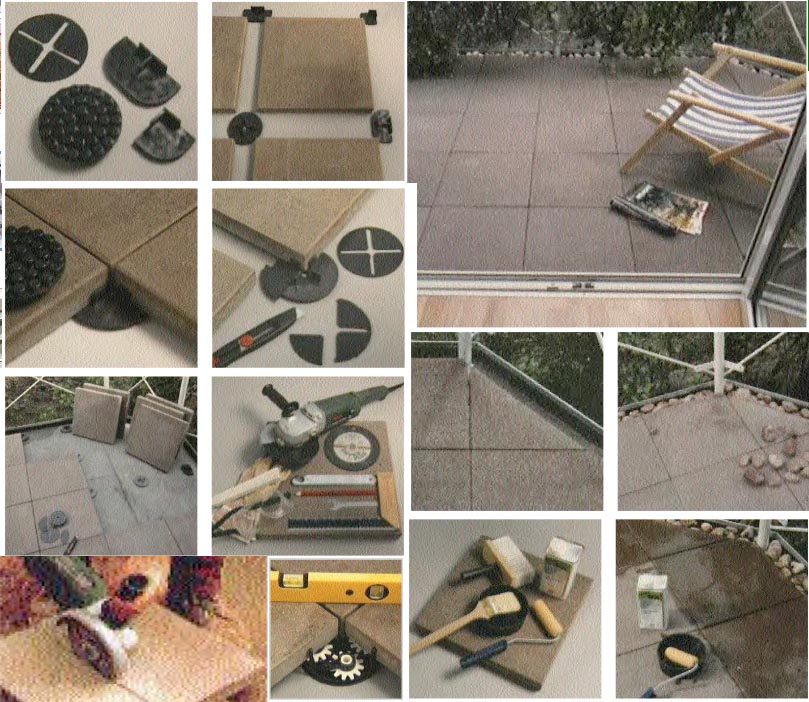 Stone slabs do not always have to be laid in a bed of sand. On the right subsoil, you can also use plate bearings.
Stone slabs do not always have to be laid in a bed of sand. On the right subsoil, you can also use plate bearings.
Sand bed or lean concrete, these are the classic backgrounds, about concrete- and stone slabs to be laid safely and flat. When there is solid ground, panels can also be laid dry. Concrete can do that, an asphalt layer, highly compacted sand or the flat roof of a building. However, the panels are not placed directly on the subsurface, but on slab storage. These are round or square supports made of rubber or plastic, that come under the corners of the panels.
A system with advantages
The panels are free from the subsoil, Rainwater can run off quickly through the slab joints and be drained off in a drainage system or run off in invisible depressions under the slabs. The drain grates can be cleaned by lifting the relevant plates. Frost problems do not arise, since the plates are not in direct contact with the ground. Isn't the ground level?, it can be compensated by intermediate layers. If the laid panels partially sag, you can also make this adjustment later.
Simple laying work
This can be demonstrated using the example of a balcony floor, how easy it is to lay with pedestals. First a center line is drawn, which is perpendicular to the house wall or. runs to the railing. This line then lies under the joint between the first two rows of panels. These rows are laid out slab by slab and one bearing is pushed underneath each one. Press the plates tightly against the dividers, so that all joints have the same width. Measure with a long spirit level or straight edge, whether the upper edges of the panels are exactly at the same height. It is compensated with intermediate storage, that you put under the corners of the slab that are too low. Is a bearing point considerably deeper, can also be a plastic- or ceramic plate can be placed under the plate bearing. The fine adjustment is carried out with intermediate storage on the plate storage. Are all whole plates laid, edge plates are measured, cut and fitted. Then the surface can be treated with impregnation.
Not forever
Slabs laid on bearings can be easily picked up again, z.B. if the surface underneath needs to be cleaned. A method, which is also suitable for rental properties, where the original condition must be restored: The plates are removed without leaving any residue.
Subsequent height adjustment
Panels laid on a special bearing can be aligned later, without having to lift them. With the help of a screwdriver, which is pushed into the joint, each panel corner is individually traced with millimeter precision- and moved away.
Ideal for terrace and balcony: precisely laid panels, resting securely and firmly on the ground. Rainwater can drain under the panels, without puddles forming. The simple system includes bearings for four corners and edge plates with two fields and corner plates with one field. There are thin intermediate bearings to compensate. Three types of slab bearings will suffice, to cover areas with rectangular panels. Requirement is, that all plates have the same thickness. Nubs on the underside make the pedestals non-slip even on smooth subfloors. The dividers ensure that the joints between the panels are of the same width. With the intermediate storage, which can be divided into segments, the height of individual panels or all four panel corners of a bearing point can be adjusted. As with tiling, the slabs are laid from a center line towards the edges. Remove excess concrete residue on the storage positions with the chisel. First lay the whole panels and align them exactly. Then measure the edge pieces or corners exactly. For complicated shapes, make a cardboard template.
You need an angle grinder with a stone to cut the stone slabs- or diamond disc. Hands and eyes are protected with gloves and goggles. Narrow edge pieces or corners are cut to fit, secured against slipping and, if necessary, laid on the outside of separated parts of slab bearings.
The joints up to the sheet metal edging or collecting channel for rainwater are filled with pebbles. This saves you having to precisely cut the edge panels. Untreated slabs of natural stone or concrete should be impregnated to prevent water absorption. Apply a primer first with regular painting tools.
Then apply the impregnation. Panels treated in this way do not become soiled as easily, hardly absorb any water and are better protected against frost.